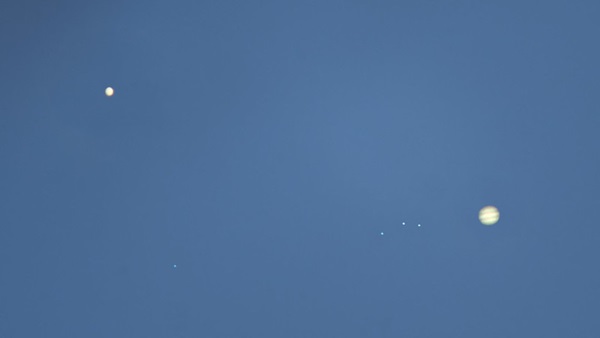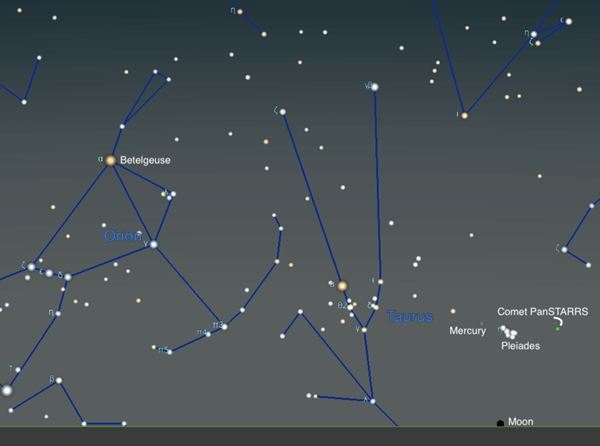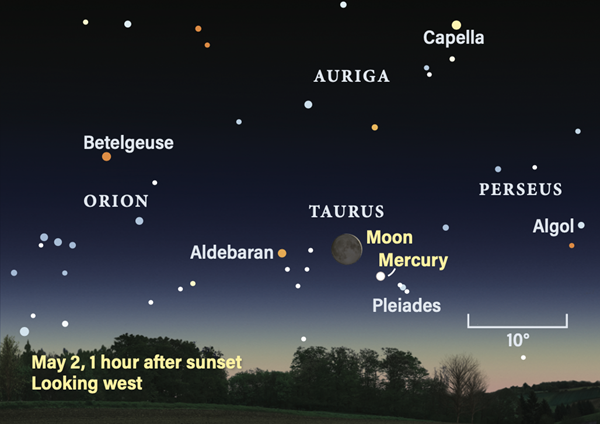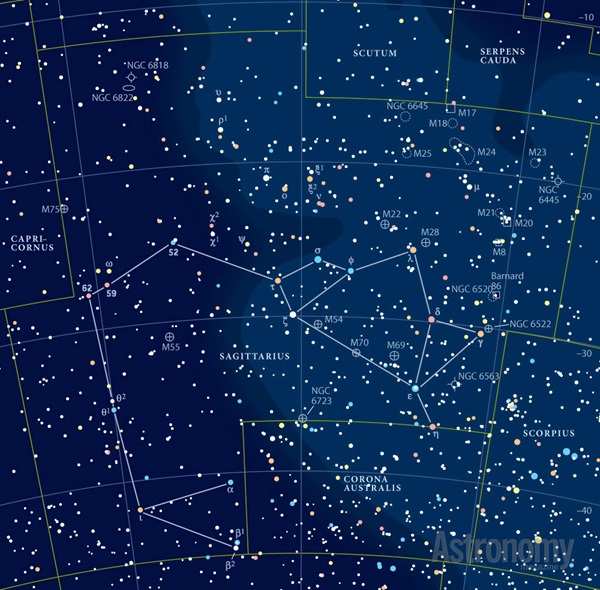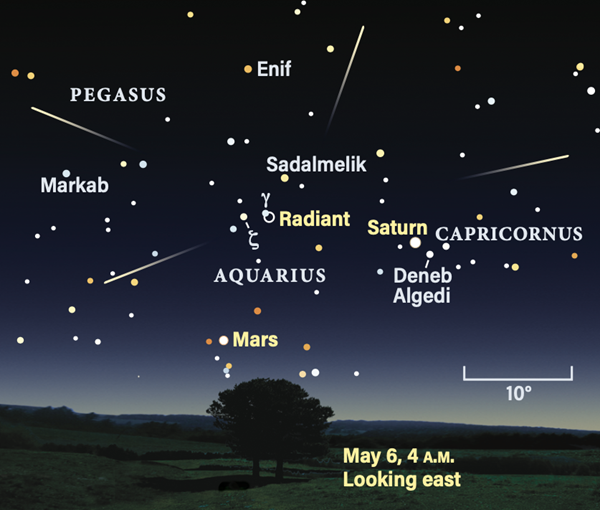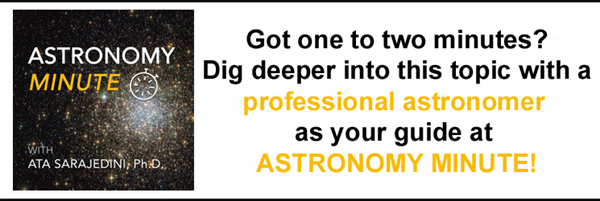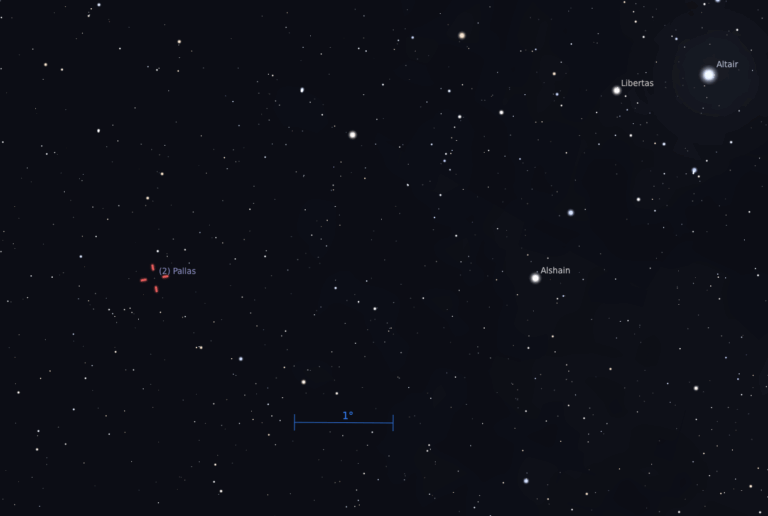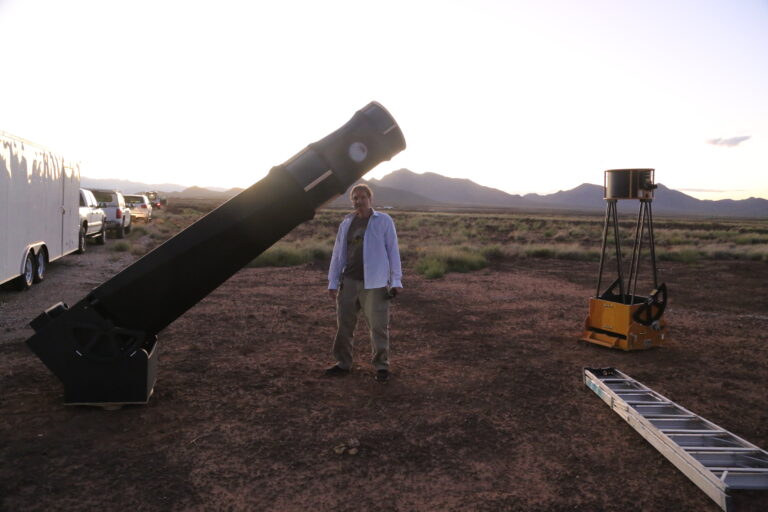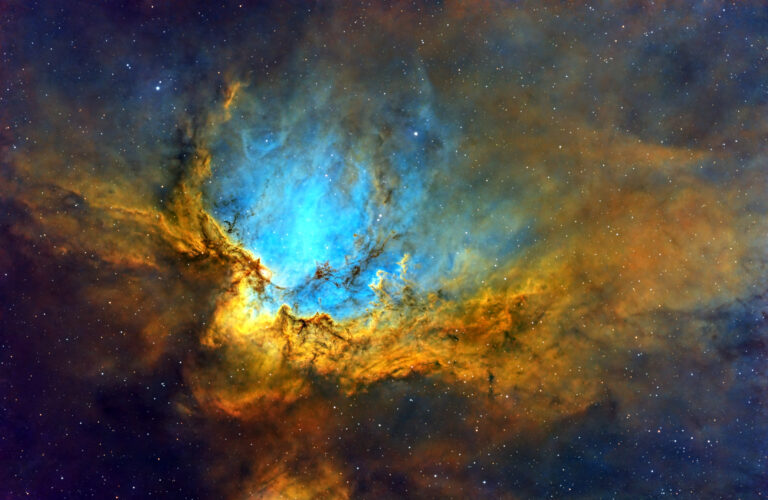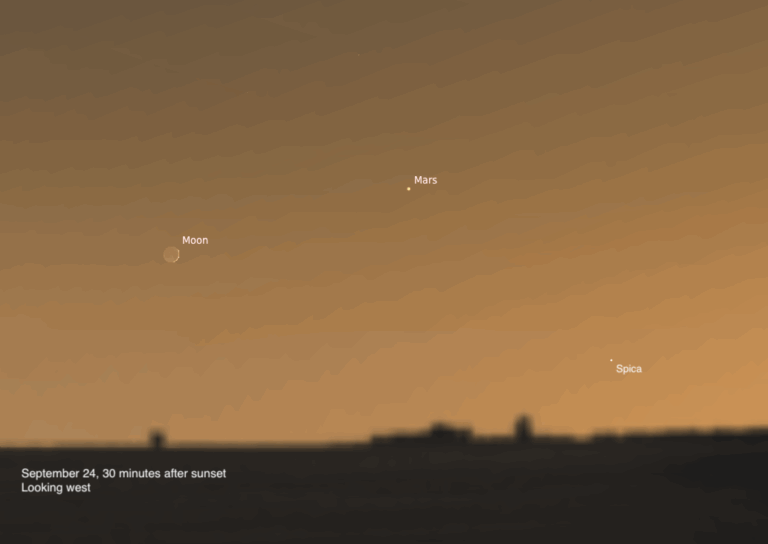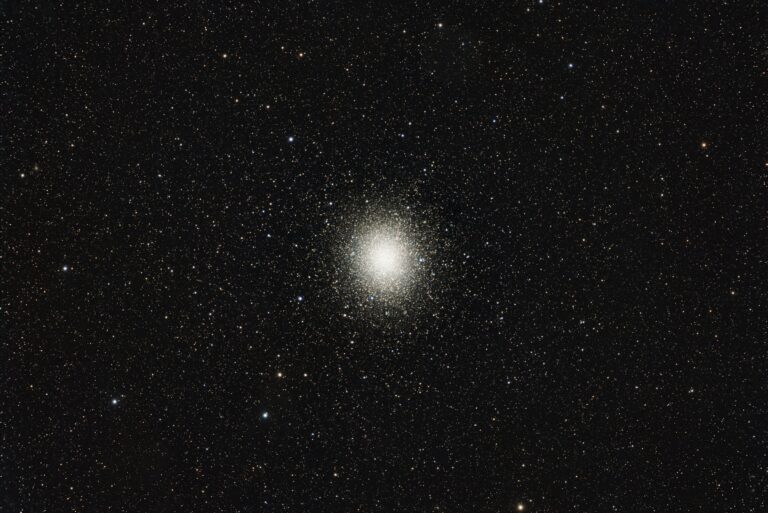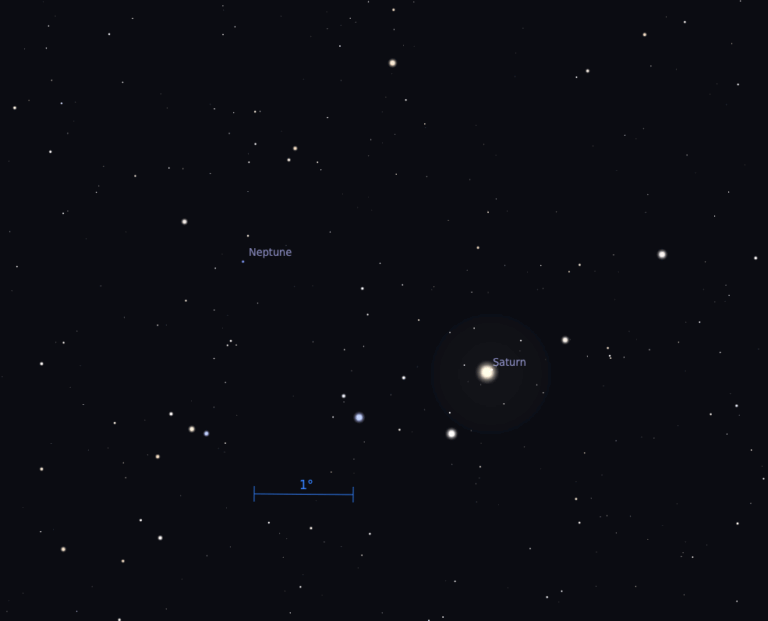Key Takeaways:
Friday, April 29
This is the best time to catch Mercury in the evening all year for those who live in the Northern Hemisphere. The smallest planet reaches its greatest eastern elongation from the Sun (21°) at 4 A.M. EDT. Shortly after sunset, its magnitude 0.2 glow will appear 20° above the western horizon. As the stars begin to come out, you’ll see that Mercury hangs less than 1.5° from the sparkling Pleiades star cluster (M45) in Taurus. Its members will pop out just north of Mercury’s position in the fading twilight. Binoculars or a low-power scope (or even your finder scope) will show both stars and planet in the same field of view.
Mercury also makes a great jumping-off point if you’re looking to try to catch Comet C/2021 O3 (PanSTARRS), whose brightness is now holding steady around magnitude 8.5. You’ll need to be quick — the comet is just 4° high an hour after sunset. You’ll find it roughly 4.5° west-southwest (lower right) of Mercury and just less than 5° directly below the Pleiades. A small telescope or 60mm to 70mm binoculars should reveal its soft, fuzzy glow.
Stay tuned later in the week, as the comet continues to pull away from the Sun in the sky and hover in darkness a bit longer each night.
Sunrise: 6:02 A.M.
Sunset: 7:53 P.M.
Moonrise: 5:38 A.M.
Moonset: 6:53 P.M.
Moon Phase: Waning crescent (1%)
*Times for sunrise, sunset, moonrise, and moonset are given in local time from 40° N 90° W. The Moon’s illumination is given at 12 P.M. local time from the same location.
Saturday, April 30
This is the conjunction you’ve been waiting for: Venus passes 0.2° (that’s 12′) south of Jupiter at 3 P.M. EDT. The event is visible in daylight but will be easiest to observer earlier in the morning before sunrise, when the planets shine brightly against the twilit sky. Venus is exceptionally bright at magnitude –4.1, showing off its 67-percent-lit disk, which stretches 17″ across. Jupiter is not quite as bright, but still unmissable at magnitude –2.1. Its broad disk spans 35″. Both hang in Pisces, some 7.5° below (southeast of) the Circlet asterism.
An hour before sunrise, the two planets are 28′ apart — still easy to capture in the same field of view with binoculars or any telescope. They’ll continue to grow closer as they rise.
At that time, three of Jupiter’s four Galilean moons are also visible: Ganymede to the east, and Io (closest) and Callisto to the west. Europa is behind Jupiter — the moon disappears behind Jupiter’s shadow before the planet rises in the U.S. and emerges around 8:30 A.M. EST, after daylight. However, those with tracking telescopes can (carefully) follow the planets into the sunlit sky and catch their closest approach in the afternoon, when Jupiter will sit due north of Venus.
The next time these planets come so close at such a decent elongation from the Sun is November 2039, so look your fill now!
New Moon Occurs at 4:28 P.M. EDT. There is also a partial solar eclipse that will take a 64-percent chunk out of the Sun, visible from a few remote regions of the world: southern South America, the southeastern Pacific, and the Antarctic Peninsula.
Finally, dwarf planet Pluto is stationary in eastern Sagittarius at 5 P.M. EDT. After today, the tiny, distant world will begin traveling southwest against the background stars, diving back toward the Teapot asterism (which we’ll visit later in the week).
Sunrise: 6:01 A.M.
Sunset: 7:54 P.M.
Moonrise: 6:02 A.M.
Moonset: 7:57 P.M.
Moon Phase: New
Sunday, May 1
Let’s go back to the evening sky to try again for a glimpse of Comet C/2021 O3 (PanSTARRS) with your binoculars or small scope. An hour after sunset, the comet is now 7° high in the west, standing 3.7° directly to the right (northwest) of the Pleiades, bringing the two roughly equally high above the horizon. Mercury now sits just over 2° east-southeast of the Pleiades, appearing to the cluster’s upper left in the sky.
As previously mentioned, the comet will continue to climb away from the Sun each night, spending longer and longer in dark skies. We’ll keep it in our sights for at least another week or two as it moves out of Taurus and into Perseus, passing by several more stunning targets in the night sky.
While you’re enjoying the comet (or, at least, the hunt for it!), take some time to glance west and catch one of your last glimpses of Orion the Hunter in the evening sky. His recognizable belt — drawn from the three stars Alnitak, Alnilam, and Mintaka — is setting swiftly, disappearing beneath the horizon about two hours after the Sun. His famous shoulder, the red giant Betelgeuse, remains in sight for about 40 minutes more. Orion will continue to set earlier each day until he’s gone from the nighttime sky entirely; he’ll return for evening viewing later this year, rising before midnight by November and December.
Sunrise: 6:00 A.M.
Sunset: 7:55 P.M.
Moonrise: 6:27 A.M.
Moonset: 9:01 P.M.
Moon Phase: Waxing crescent (1%)
Monday, May 2
The Moon passes 1.8° south of Mercury at 10 A.M. EDT. By sunset, our satellite lies roughly 4.2° due east of the planet, which has now slightly faded to magnitude 0.6. You can watch the pair sink toward the western horizon as the sky grows darker, following the Sun out of sight as they set around 10 P.M. local time. Zoom in on Mercury with a telescope, and you’ll see its 9″-wide disk is 27 percent lit. Compare that with our Moon, who’s showing off just 5 percent of her face. Luna’s eastern limb (west on the sky) is just becoming visible as our satellite slowly waxes from New. These regions are now experiencing lunar sunrise.
As the stars begin to appear, you’ll see both of Taurus’ most famous naked-eye clusters: the Pleiades to the west (lower right) of the Moon and Mercury, and the Hyades to their south (lower left). Both clusters are young, but they look quite different. The Pleiades, which astronomers believe are roughly 100 million years old, are much more compact, covering some 110′ on the sky. By contrast, the Hyades, which are an estimated 950 million years old, span some three times that amount, stretching over about 330′, sprinkled across the Bull’s nose.
Sunrise: 5:59 A.M.
Sunset: 7:56 P.M.
Moonrise: 6:57 A.M.
Moonset: 10:03 P.M.
Moon Phase: Waxing crescent (3%)
Tuesday, May 3
Leo the Lion still reigns high in the southwestern sky after dark, slowly making his way toward the horizon as the hours pass. He won’t set until early tomorrow morning, making this constellation a great place to spend your evening hours.
Leo contains five Messier objects, all galaxies: M65, M66, M95, M96, and M105. The brightest is magnitude 8.9 M66, which sits about 2.8° southeast of 3rd-magnitude Chertan in the Lion’s hindquarters. M66 is also part of the famous Leo Triplet of galaxies, together with NGC 3628 (magnitude 9.5) and M65 (magnitude 9.3). While you can see M65 and M66 in nearly any binoculars, if you watch to catch all three members of this group, you’ll want 70mm (or larger) lenses or a small telescope to bring out edge-on NGC 3628 as well. A wide field of view (roughly 1°) will show all three at once.
These three spiral galaxies are not only apparently grouped together on the sky, but physically close together as well, each interacting with the others. The entire group lies about 35 million light-years away.
Sunrise: 5:58 A.M.
Sunset: 7:57 P.M.
Moonrise: 7:32 A.M.
Moonset: 11:04 P.M.
Moon Phase: Waxing crescent (8%)
Wednesday, May 4
The Moon passes 0.008°, or a mere 29″, south of dwarf planet 1 Ceres at 10 A.M. EDT, resulting in an occultation from some locations on Earth. By this evening, they’ve separated considerably and stand nearly 5° an hour after sunset. The Moon is now located in far western Gemini, while Ceres stands over the border in eastern Taurus. The 9th-magnitude main-belt world is just northeast of a line drawn between the Bull’s two horns, Alheka and Elnath, and is due west of the Moon.
The pair is sinking in the west, along with another target you’ll want to be quick about — but one that’s worth pursuing this May the Fourth. NGC 2359 is an emission nebula commonly known as Thor’s Helmet, but it’s recently been given another nickname as well: the Baby Yoda Nebula, after The Mandalorian’s popular character Grogu. That’s because the glowing gas not only looks a bit like the Norse god’s winged helmet, but also Grogu’s round head with its long, pointed ears.
Located in northeastern Canis Major, NGC 2359 is just under 9° northeast of Sirius. This region is setting in the southwest, with the nebula about 18° high an hour after sunset. If you have a go-to scope, you can punch in the nebula’s NGC number, or try finding it by pointing at the 11th-magnutude star HIP 35378, which is the massive young sun responsible for the glowing gas.
In a 6-inch or smaller scope, Grogu will appear only as a fuzzy patch in the sky around the star’s location. Slightly larger scopes may begin to show the arcs of his ears. If you want to make out more detail, you’ll need to go even bigger: 10 inches or more of aperture. Astrophotographers can try capturing the Child even with smaller scopes; try using a narrowband filter and a longer focal length (400mm or greater), plus plenty of exposure time.
Sunrise: 5:56 A.M.
Sunset: 7:58 P.M.
Moonrise: 8:12 A.M.
Moonset: —
Moon Phase: Waxing crescent (13%)
Thursday, May 5
Uranus is in conjunction with the Sun at 3 A.M. EDT. A few hours later, the Moon reaches apogee, the farthest point from Earth in its orbit, at 8:46 A.M. EDT. At that time, our satellite will be 251,833 miles (405,286 kilometers) away.
On early May mornings, the center of the Milky Way — which sits in Sagittarius — is on prime display. A few hours before sunrise, look south to find the Teapot asterism, which is drawn from eight of the Archer’s stars: Lambda (λ), Phi (φ), Sigma (σ), Tau (τ), Zeta (ζ), Epsilon (ε), Gamma (γ), and Delta (δ) Sagittarii. Lambda, Phi, and Delta form the triangle-shaped lid of the Teapot. Its handle contains the stars Phi, Sigma, Tau, and Zeta; the spout is drawn from Delta, Gamma, and Epsilon.
This entire region is rich in deep-sky objects for early risers to enjoy. Just off the tip of the Teapot’s top, you’ll find M28, a 7th-magnitude globular cluster some 18,000 light-years away. This concentrated clump of stars spans about 11′ on the sky — look for it in binoculars or a low-powered scope just under 1° northwest of Lambda Sagittarii.
Additionally, three of Messier’s globulars sit within the body of the Teapot, near the line connecting Zeta and Epsilon (which form its base). These are, from east to west, M54 (magnitude 7.6), M70 (magnitude 7.9), and M69 (magnitude 7.6). M54 and M70 both sit nearly in line with these stars, while M69 is just over 2.5° northeast of Epsilon.
Sunrise: 5:55 A.M.
Sunset: 7:59 P.M.
Moonrise: 8:59 A.M.
Moonset: 12:00 A.M.
Moon Phase: Waxing crescent (21%)
Friday, May 6
The Eta Aquariid meteor shower peaks this morning under dark, moonless skies, as the waxing crescent Moon sets before 1 A.M. local time for most locations. The shower’s radiant, which sits near Sadachbia (Gamma Aquarii), rises in the east around 2:30 A.M. local time. An hour and a half later, it is some 17° above the horizon — still a bit low, but high enough that you’re still likely to catch several shower meteors streaking away from this point and across the sky.
The shower’s expected maximum zenithal hourly rate is some 50 meteors per hour. Unfortunately, the radiant’s low altitude and the encroaching twilight will somewhat attenuate this rate, but early risers will still be rewarded with some additional five to 10 meteors per hour above the sporadic background rate before dawn.
These particular meteors are born from debris left by the famous Halley’s Comet when it swings through the inner solar system every 75 to 76 years. They streak through our atmosphere at some 40 miles (64 km) per second. The Eta Aquariids may peak this morning, but the shower will last for three more weeks (until May 28), so it’s worth continuing your search for shower meteors throughout much of the month.
Sunrise: 5:54 A.M.
Sunset: 8:00 P.M.
Moonrise: 9:52 A.M.
Moonset: 12:51 A.M.
Moon Phase: Waxing crescent (29%)

